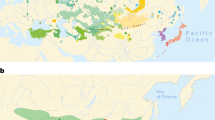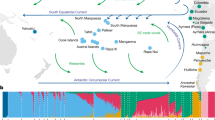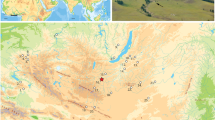Abstract
The origin of the Polynesian islanders and of the Austronesian languages that they speak has been debated for more than 200 years. Diamond has presented the predominantly held modern viewpoint, described as the 'express train to Polynesia' model, which proposes that the ancestors of the Polynesians were early farmers who dispersed south from a homeland in South China/Taiwan, through Island Southeast Asia (replacing an indigenous 'Australoid' hunter-gatherer population), and then on east, out into the Pacific — all within the past 6,000 years1. However, evidence is accumulating from several genetic markers that Polynesian lineages have a much deeper ancestry within tropical Island Southeast Asia than this hypothesis would suggest. The new evidence implies that the Polynesians originated not in China/Taiwan, but in eastern Indonesia, somewhere between Wallace's line and the island of New Guinea.
This is a preview of subscription content, access via your institution
Access options
Subscribe to this journal
Receive 51 print issues and online access
$199.00 per year
only $3.90 per issue
Buy this article
- Purchase on Springer Link
- Instant access to full article PDF
Prices may be subject to local taxes which are calculated during checkout

Similar content being viewed by others
References
Diamond, J. M. Nature 403, 709–710 (2000).
Melton, T. et al. Am. J. Hum. Genet. 57, 403–414 (1995).
Redd, A. J. et al. Mol. Biol. Evol. 12, 604–615 (1995).
Richards, M., Oppenheimer, S. J. & Sykes, B. Am. J. Hum. Genet. 63, 1234–1236 (1998).
Bellwood, P. in Prehistory of the Indo-Malaysian Archipelago 2nd edn, 119 (University of Hawai'i Press, Honolulu, 1997).
Su, B. et al. Proc. Natl Acad. Sci. USA 97, 8225–8228 (2000).
Serjeantson, S. W. & Hill, A. V. S. in The Colonization of the Pacific: A Genetic Trail (eds Hill, A. V. S. & Serjeantson, S. W.) 286 (Clarendon, Oxford, 1989).
Baer, A. S. Asian Perspectives 34, 21–35 (1995).
Hanihara, T. Anthropol. Sci. 101, 25–46 (1993).
Meacham, W. Asian Perspectives 26, 89–106 (1984).
Solheim, W. G. II in The History of Humanity Vol. 1 (ed. De Laet, S. J.) 468–481 (Routledge, London, 1994).
Terrell, J. E. & Welsch, R. L. Antiquity 71, 548–572 (1997).
Blust, R. Symp. Ser. Inst. Linguist. Acad. Sinica 1, 31–94 (1999).
Author information
Authors and Affiliations
Rights and permissions
About this article
Cite this article
Oppenheimer , S., Richards, M. Slow boat to Melanesia?. Nature 410, 166–167 (2001). https://doi.org/10.1038/35065520
Issue Date:
DOI: https://doi.org/10.1038/35065520
This article is cited by
-
Global analysis of saliva as a source of bacterial genes for insights into human population structure and migration studies
BMC Evolutionary Biology (2014)
-
Reconstructing Austronesian population history in Island Southeast Asia
Nature Communications (2014)
-
Human melting pots in southeast Asia
Nature (2014)
-
Hypertension-susceptibility gene prevalence in the Pacific Islands and associations with hypertension in Melanesia
Journal of Human Genetics (2013)
-
The Indonesian archipelago: an ancient genetic highway linking Asia and the Pacific
Journal of Human Genetics (2013)
Comments
By submitting a comment you agree to abide by our Terms and Community Guidelines. If you find something abusive or that does not comply with our terms or guidelines please flag it as inappropriate.



